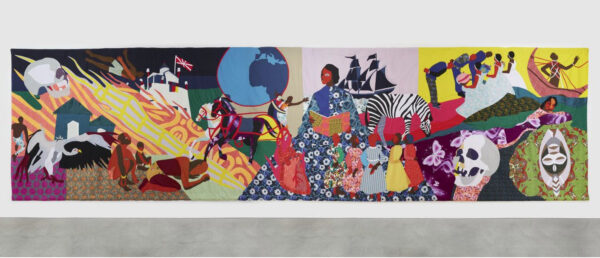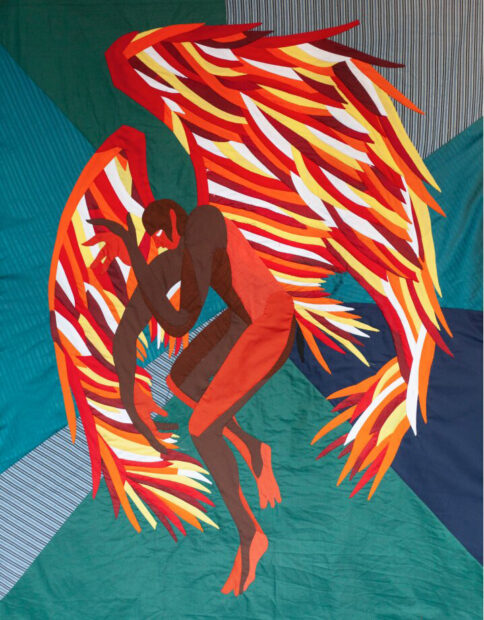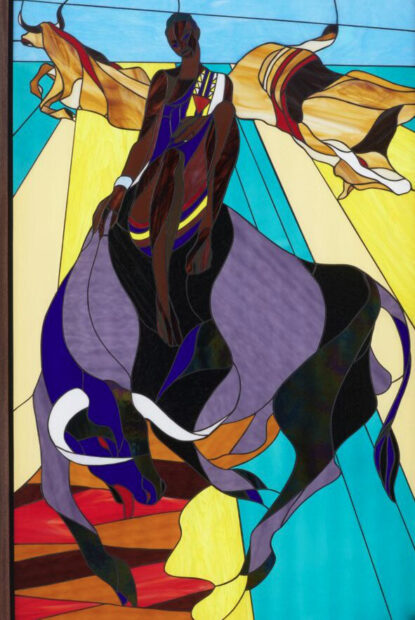Richly embellished tapestries that display sinuous narratives, brightly florid stained glass lightboxes, glittering gold bells and lustrous microscopes, performative shrines, theater costumes, allegorical figures, ancient myths and symbols notably imagined by an artist’s radical collision of thoughts: This is what Christopher Myers’ of all creatures that can feel and think comprises. The seventeen pieces, on view at the Blaffer Art Museum through September 3, showcase Myers’ worlds wrought into a singular exhibit; the works converse with each other’s underlying pictorial vocabulary.
Through Myers’ stained glass lightboxes, luminous color is suspended upon the gallery walls, presenting an impressive talent at storytelling and materiality. The artist explores the boundaries between human and nonhuman, both figuratively and physically, through compositions of manufactured yet pure color and detailed black lines that vary in thickness. This beautiful materiality not only brings light and a fairy tale-like feeling to the Blaffer, but most significantly, it introduces important histories to the works’ spectators.
Just as one enters, they are immediately struck by Nat Turner (2022), a stained glass work of vibrantly complex color and even more complex history. In it, Myers recounts the story of Nat Turner, an enslaved preacher who masterminded the Four-Day Rebellion of 1831. The figure of Turner lays down upon a corn field, upturned with his arms held towards the sky. This is a call back to the ‘Damascus experience’ of Turner’s conversion to Christianity after hearing the voice of God call out to him. Myers does not exclude art historical references to his works either; the positioning of Turner alludes to Caravaggio’s Conversion of Saint Paul from 1600.

Christopher Myers, “Sarah Forbes Bonetta as Omoba Aina as Persephone,” 2021, appliqué textile. Photo: Fernanda Calero.
In the instances in which stained glass is utilized, I would guess viewers relate this artistic technique to that found in the many churches and cathedrals across the globe: a translucent painting or fresco that can inspire the souls of the public who, from time to time, have visited such an ecclesiastical monument. Strolling through a cathedral, one may find themselves stopped by the multicolored reflections of these windows upon the floors, encountering a work of art that has stood for centuries. Of course, what gives such windows life is light. Yet, Myers has accomplished the harmonious creation of illuminated stained glass works that brings a centuries-old creative tradition inside.

Christopher Myers, “A Very Old Man with Enormous Wings,” 2021, appliqué textile. Photo: Fernanda Calero
You cannot confront an exhibition such as this without recognizing the historical, narrative, moral, and socio-political stances that are included in the artist’s aesthetic banners of discovery. A question for the show’s curator would be how to organize such resonant material, both historically and conceptually, while making sense of the artist’s stated themes. Myers does not shy away from combining Greek, East Asian, and African myths into a single work, referencing unknown fairytales as well as notorious historical figures such as Leopold II of Belgium. The pieces also make note of scientific discoveries, and point out social and political disparities.
Myers’ sublimely illustrated stained glass work Nongqawuse (2022) tells the story of a young Xhosa girl and prophet who sits gracefully upon a horned bull, a re-imagining of the infamous Greek myth of Zeus and Europa, in which Zeus morphs into a bull to take Europa away from her island. Myers utilizes such a prevalent myth in art history and classical studies to confront colonial histories in Africa.
Directly across from Nongqawuse is Nala Damajanti as Mami Wata as Cymbee (2022), a work that similarly traverses histories of colonialism, the Black diaspora, and the spiritual dissemination across the Americas, East Asia, and Africa. The pieces reflect upon each other in both a figurative and literal sense, as the brightly colored light from one work bounces off the other, converging in the center of the gallery where the mosaic of color merges beneath the spectators’ feet. In between them, six titillating tapestries that mimic ritual flags introduce exquisitely tactile motifs of wide-ranging stories.
Myers’ works dig into chronicles that he wishes to liberate from the archival room. (The artist is himself is an avid researcher and son to a collector of historic letters.) Looking towards artisans in Egypt, Mexico, Indonesia, Vietnam, and Kenya, Myers collaboratively works with craftspeople across the world to create his pieces, establishing a cross-pollination of thought, creativity, and labor. Narrative representation provokes the viewer to closer analysis and contemplation, allowing a discovery of archetypes, unknown myths, and human networks that connect Myers to the whimsical history of humankind.
Mystical bodies, winged angel-like figures, half-animal humanoids, horned animals and serpentine realms, embellished impressions of ancient Greek figures, Latin narrative poems, storybooks by famed Colombian author Gabriel García Márquez, and Chinese mythology all materialize in the fine threads and stitching of Myers’ tapestries. On the rare occasion a mortal sways through the textile material, it is not without a magical anima.
Of all creatures that can feel and think is a rubber band on the wrist, snapping the spectator into a world of realization and focus. Myers’ works resuscitate figures and stories from the archives and the ashes of history to initiate an investigation into the colonial, racial, and social bones that support the American nation. The Blaffer has given way to such inquiries to present themselves in Houston through the fabled, classical, and mythical conceptions of Myers’ oeuvre.
Christopher Myers: of all creatures that can feel and think is on view at the Blaffer Art Museum in Houston through September 3, 2023.




